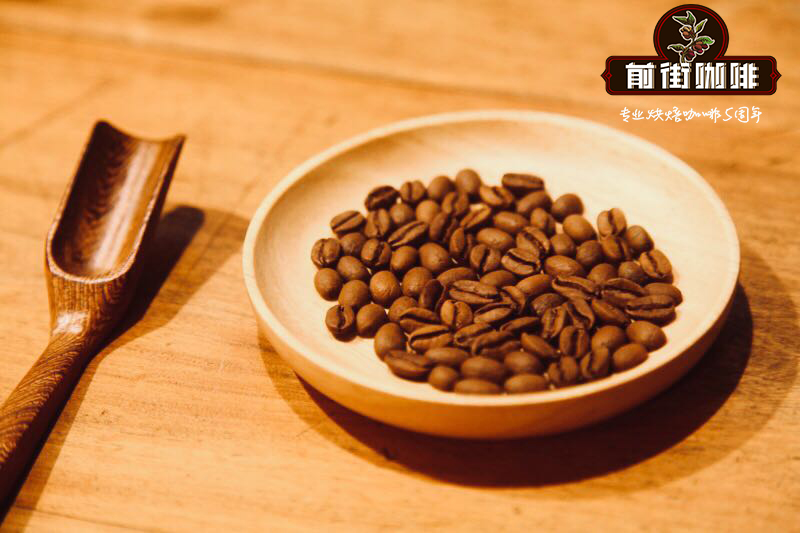Introduction of coffee characteristics of Central American coffee beans

Professional coffee knowledge exchange more coffee bean information please follow the coffee workshop (Wechat official account cafe_style)
Central American coffee
Central America is the land bridge connecting North and South America.
There are seven countries, namely Belize, Costa Rica, El Salvador, Guatemala, Honduras, Nicaragua and Panama. Seven Central American countries all produce coffee, of which Guatemala, Costa Rica and Honduras are among the top 10 global coffee exporters.
Coffee began to flourish in Central America in the 18th century, and this important economic product originated in Costa Rica around 1840.
Since Central America became independent from Spain in 1821, there has been a lot of war. Costa Rica was far from Guatemala City, the capital of the Spanish colony at that time, and was not affected by the civil war. On the contrary, it was Guatemala and El Salvador that delayed the production of coffee because of the civil war.
After that, the political dispute gradually subsided, and with the exception of Honduras, Central American countries began to produce coffee in the 19th century.
Central America has the natural advantages of sunshine, land, and mountains, and an abundant working population, which makes the region unique in growing and producing high-quality coffee.
In the late 19th century, coffee had become an indicator of economic growth in Central American countries, and all Central American countries passed a bill to promote coffee.
With the most remarkable results in countries such as Costa Rica, El Salvador and Guatemala, coupled with the scientific and technological way of growing coffee, Central America has become one of the four largest coffee producing areas in the world.
Coupled with the scientific and technological way of growing coffee, Central America has become one of the four largest coffee producing areas in the world.
Introduction to Coffee characteristics of Central American countries
Costa Rica
The seven main coffee producing areas are distributed along the inland central plateau from northwest to southeast. Costa Rican volcanic terrain with fertile volcanic ash, mild and suitable temperature, and stable and abundant rainfall is one of the reasons why coffee has become one of the main agricultural products in Costa Rica.
As the coffee industry in Costa Rica began to develop since the middle of the 18th century, it was the first country where coffee was first introduced into Central America and has a long history, so the coffee organization has a complete system from production to marketing. In terms of quality and quantity, Costa Rican coffee has always been recognized by the world, and has been rated as the world-class high-quality coffee.
Its coffee beans are all Arabica species. Pure flavor, pleasant aroma, both in acidity and taste have an unassailable balance, suitable for a single coffee, can also be mixed into a comprehensive coffee.
Western valley
West Valley
1000-1200
November-March
High acidity
The bean body is full.
The aroma is fragrant
The acidity and bean body can not compete with beans from other producing areas, but the overall taste is well balanced, with hints of almonds and peaches.
Central valley
Central Valley
1200-1600
November-March
High acidity in the mouth
The bean body is full.
Rich fragrance
Coffee in this area is the earliest coffee growing area in Costa Rica, with rich volcanic soil and sometimes chocolate aroma.
Tarasu
Tarrazu
1200-1700
December-March
High acidity in the mouth
The bean body is hard and full.
Rich fragrance
This area is a world-famous producing area, and its main feature is that the high seafood area creates an unparalleled perfect taste.
Three rivers
Tres Rios
1200-1650
December-March
High acidity in the mouth
The bean body is hard and full.
Rich fragrance
The climatic conditions are good, the taste is obvious, and the balance is very good.
Eurosi
Orosi
9-1200
September-February
A smooth sour taste
The bean body is full.
The aroma is fragrant
The coffee in this area tastes smooth and balanced.
Brenka.
Brunca
800-1200
August-January
General acidity
Fullness
The smell is ordinary.
The newest producing area of Costa Rica is suitable for all kinds of consumers and the taste is compatible with other producing areas.
Duli Alba
Turrialba
600-900
July-December
General acidity
The bean body is thin.
The aroma is fragrant
The harvest season in this area is the earliest among all the producing areas in Colombia, mainly due to the influence of abundant rainfall.
El Salvador
Active volcanic activity brings mineral-rich volcanic ash, mainly volcanic ash, to Saudi Arabia.
In the soil, there are more minerals and less organic matter. therefore, in order to maintain the geographical position and make up for the lack of organic matter, Samaritan farmers will use the pulp residue of the treated coffee beans or the organic matter under the coffee trees as fertilizers to make up for the lack of organic matter in the soil, so that the planting of coffee trees can produce coffee beans with harmonious taste. The country's most meaningful initiative is to introduce organic agriculture to the world, cultivating more than 150000 tons of organic coffee every year.
Sa coffee has five major producing areas (Apaneca, Central Belt, Chichontepec, Tecapa)
& Cacahuatique Mountain Range), generally distributed in the alpine slopes or plateau areas covered with volcanic ash at an altitude of 1200 meters, and the coffee harvest and harvest season is from November to April of the following year. As coffee prefers a mild climate, coffee trees are mainly planted in the shade of tall trees (shade grown coffee) in order to avoid excessive temperature and direct sun exposure, affecting the quality of coffee beans. The coffee beans produced by it belong to Arabica species, mainly from Pacas and Bourbon brands, and belong to big beans with sweet taste and excellent flavor.
Planting height
Cup test trait
600-900 meters above sea level
Supple, pure aroma, no sour, light texture beans 901-1200 meters above sea level happy beautiful fragrance, sour taste more than 1200 meters above sea level
Joyful aroma, delicious comfort, sour taste and excellent texture are the ten elements of fine coffee (Gourmet coffee).
Coffee must be at least 90% bourbon, Pacamara or Maragogipe
100% fully matured into red wine color
The manufacturing process is separate from other coffees to avoid adulteration with other inferior coffees to ensure good quality. Wash with clean fresh water. 100% sun. Hand-picked fruits and washing. Make sure that each bean is flawless. Green beans must be turquoise and packaged safely.
Average humidity does not exceed 12%
organic coffee
It's grown completely without pesticides and every bean has been internationally organized.
Organic Crop Improvement Association
Guatemala
Guatemala has seven major coffee producing areas, all of which are Arabica coffee beans. They are located in the highland terrain under subtropical climate. The rainfall is abundant and stable, and the fertile volcanic ash soil makes all parts of Guatemala have natural environmental conditions suitable for coffee cultivation. Each region has a unique flavor, superior acidity and fruity smooth mouth, belongs to one of the world's top coffee, suitable for single drink.
(m)
production season
Antigua Classic
Rich volcanic soil, low humidity, intense sunlight and cool evening winds characterize the Antigua region. Three spectacular active volcanoes-Jagua, Yactinigua and Fugua form a beautiful valley. Fugua active volcanoes also occasionally add misty dust. High-quality Antigua coffee is rich and mild, with rich aromas and good acidity.
1,500-1,700
January-March
Rainforest Coban
The Coban rainforest region is distinctly different from other coffee-producing regions in Guatemala. It is foggy, rainy and cool all year round. The soil composition is calcareous and clay. Influenced by the tropical climate of the Atlantic basin and the jungle stretching north, coffee in this area is mostly grown on obviously slow hilly land. The coffee characteristics of this region are clearly different from those of other regions in Guatemala. Full bodied beans with a bright and subtle acidity and a light wine aroma.
1,300-1,500
December-March
San Marcos Volcano
Volcanic San Marcos
It is the warmest coffee-producing region in Guatemala. The rainfall in this area is abundant, the rainy season is the most dense, and the flowering period is the earliest. The rainy season peaks between June and September, with torrential downpours, with annual rainfall reaching as high as 197 inches in some areas. The coffee in this area has obvious sour taste, full bean body, with a clear, light floral aroma.
1,400-1,800
December-March
Traditional Atitlan
One of Guatemala's four major volcanic coffee regions. Etienne's soil is the most fertile of organic matter. Ninety percent of the coffee is grown along steep slopes that extend to Lake Etienne, the largest and most famous of Guatemala's volcanic lakes. The coffee in this area is fragrant, with intoxicating aroma, sour taste and sweet taste, and full of coffee beans.
1,500-1,700
December-March
Highland Huehue
The driest and highest of the three non-volcanic regions producing single-origin coffee. Tenangao is currently the most rugged and remote place in Guatemala. The mountains are frost-free thanks to dry, hot winds blowing into them from Mexico's Emperor Depecq Plain, which makes it possible to grow coffee at heights of 6,500 feet. The coffee beans in this area are firm and full, with a special acidity and a slight wine aroma.
1,500-2,000
January-April
Farrakhan
Nice Plain
Fraijanes Plateau
The volcanoes in this area are quite high in altitude, the soil is rich in pumice, and the Farahannis Plain is still an active volcanic area, so the coffee in this area has quite similar characteristics to Antigua. However, abundant rainfall, high and variable humidity, and wide temperature differences give Farrahanis a very different flavor. Farrahanis coffee has a rather elegant aroma, a mild and mellow overall texture, with a special and pleasant acidity.
1,400-1,800
December-February
new Oriental
New Oriente
Rainfall is abundant, under the shade of clouds all the year round, New Oriental is similar to Cobain in climate, only a small difference. Formerly a volcanic area, the soil contains metamorphic rocks. The minerals in the soil are balanced by the abundance of metamorphic rocks. Coffee cultivation is also quite different from that of volcanic areas in Guatemala. New Oriental coffee grows in volcanic soils without volcanic activity during its growth. New Oriental is Guatemala's newest coffee-growing region, characterized by aroma, pronounced acidity and good texture.
1,300-1,700
December-March
Honduras
There are 280,000 hectares of coffee plantations in Honduras, dominated by small coffee growers, most of which are less than 3.5 hectares, and these coffee growers account for 60% of Honduras 'production. In coffee gardens, men and women collect coffee beans by hand, carefully process them and craft them to meet the needs of the market and meet the different tastes of consumers. Honduras harvests 3 million bags of coffee every year, providing the world with perfect coffee and unique coffee aroma, quality and quality, and has become the second largest coffee exporter in Central America and the tenth largest in the world. The coffee industry in Honduras is linked to the livelihood of 100,000 families in Honduras, creating a million jobs and creating a permanent economic foundation for Honduras.
Honduras coffee is divided into six regions, located in the west and south, namely Santa Barbara, El Paraiso, Copan, La Paz, Comayagua and Olancho, with an average planting height of more than 1,100 meters above sea level. Coffee varieties are 100% Arabica, 69% HG, 12% SHG and 19% CS. The main brands are Typica, Bourbon, Caturra, Villa Sarchi and Lempira. Hong Kong coffee quality is first-class, its price is also the most competitive in Central America.
Small, round, slightly pale green coffee, highly acidic, full and slightly sweet, suitable as a blend coffee, can also be made into single coffee, suitable for medium and deep roast, mainly exported to the United States, Germany and Japan.
Nicaragua
It is mainly divided into four regions: Segovias, Matagalpa/Jinotega, Boaco and Pacific Coast. The highest planting height in Segovia is around 1,500 - 2,000, and the coffee produced is the highest grade SHG (Strictly High Grown).
The volcanic ash and shady cultivation produce high-quality Nicaragua coffee with a mild, mild, slightly acidic flavor suitable for mixed coffee. The volume of Nigerian coffee is the largest of all coffee beans, of which the largest beans produced in Madagalpa are the most distinctive. This giant bean is larger than the average coffee bean, commonly known as the elephant bean, has a distinctive special aroma, and Maragogipe coffee has a round texture, its sister Matagalpa contains wild acidity, with indescribable aroma.
Coffee trees in this area are ancient bourbon species, usually grown on slopes between 1200 and 1500 Michael above sea level, and have been recognized by OCIA (Organic Crop Improvement Association) as excellent organic coffee at high altitudes. Nigerian coffee is especially suitable for deep roasting and is recommended for brewing espresso coffee.
Panama
Coffee was introduced to Panama in 1780, when Europeans brought in the first Typica species.
After this mysterious and strange drink conquered the senses of Panamanians, the locals began to cultivate it. Panama coffee is smooth, full weight, light weight, and perfectly balanced acidity. Its fine coffee beans have pure flavor and character. Medium roast is recommended. Many buyers like to mix Panamanian beans, and almost all of the premium coffee beans are shipped to France and Finland.
producing areas
characteristics
Boquete
This region produces a variety of coffee quality fine, Panama's largest coffee production, the best quality areas.
Volcanic area (Volcan)
The coffee produced here is characterized by a mild and balanced taste, which has gradually attracted the attention of international connoisseurs and coffee lovers and is believed to soon be on par with Puerto Rico.
Santa Clara District
(Santa Clara)
The fertile coffee garden is watered by clear rivers brought by Chorerra Falls, and the nearby Panama Canal makes it easy for fresh and authentic Panamanian coffee to be transported to all parts of the world.
Kendra district
(Piedra de Candela)
The most promising is the potential to vigorously develop high-quality premium coffee.
Belize
Organic coffee, which belongs to Arabica and is grown in the rainforest, grows naturally around the rainforest and does not use any herbicides or insecticides. The perfect humidity and heat give birth to Belize's unique coffee. Mild taste, suitable for medium roasting, whether mixed coffee or single serving is suitable. Due to the scarcity of output, it is not easy to buy.
END
Important Notice :
前街咖啡 FrontStreet Coffee has moved to new addredd:
FrontStreet Coffee Address: 315,Donghua East Road,GuangZhou
Tel:020 38364473
- Prev

Iron pickup Typic gene mutant iron pickup variety Sumatra Mantenin
Professional coffee knowledge exchange more coffee bean information please follow Coffee Workshop (Wechat official account cafe_style) Typic: the oldest native variety in Ethiopia, all Arabica are derived from Tibica. The top leaf of Tiebika is bronzed and the bean body is oval or thin in shape; the flavor is elegant, but the physique is weak, the disease resistance is poor and the fruit yield is less. Jamaica Blue Mountains, Sumatra
- Next

Introduction of Colombia Colombis Dumbo Manor introduction to the flavor of Colombian washed coffee
More information on coffee beans Please follow Coffee Workshop (Wechat official account cafe_style) Local coffee farmers grow coffee along the highlands of these mountains, which have the conditions for a variety of climates; and because of changes in topography and altitude, a large part of Colombia's coffee industry is produced by small farmers. But unlike the coffee-producing countries in Central America, they tend to grow.
Related
- Detailed explanation of Jadeite planting Land in Panamanian Jadeite Manor introduction to the grading system of Jadeite competitive bidding, Red bid, Green bid and Rose Summer
- Story of Coffee planting in Brenka region of Costa Rica Stonehenge Manor anaerobic heavy honey treatment of flavor mouth
- What's on the barrel of Blue Mountain Coffee beans?
- Can American coffee also pull flowers? How to use hot American style to pull out a good-looking pattern?
- Can you make a cold extract with coffee beans? What is the right proportion for cold-extracted coffee formula?
- Indonesian PWN Gold Mandrine Coffee Origin Features Flavor How to Chong? Mandolin coffee is American.
- A brief introduction to the flavor characteristics of Brazilian yellow bourbon coffee beans
- What is the effect of different water quality on the flavor of cold-extracted coffee? What kind of water is best for brewing coffee?
- Why do you think of Rose Summer whenever you mention Panamanian coffee?
- Introduction to the characteristics of authentic blue mountain coffee bean producing areas? What is the CIB Coffee Authority in Jamaica?

